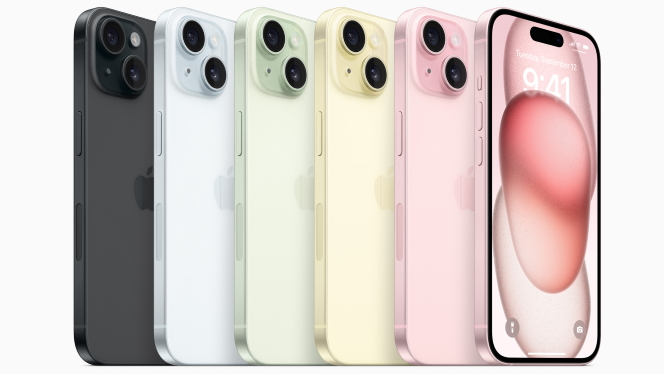TECH NEWS – Faulty displays, overheating and other such tidbits could be in store for would-be iPhone 15 owners…
Dark clouds are gathering over Apple’s iPhone 15 sky. A new report by The Information does not claim that two Chinese display companies, Lens Technology and Biel Crystal, have ever falsified their reports to Apple. It does, however, claim that 30% of iPhone screens were discarded as defective. All this allegedly cost Apple hundreds of millions of dollars. After Apple introduced a new bar-coding system engraved into the glass, the failure rate has now fallen to 10%. But it still seriously affects new iPhones.
In fact, there are two QR codes in the screen of every iPhone, and they are added at different points at different stages of production.
The information is contradictory about the size of the codes: one is claimed to be the size of a grain of sand but is later described as 0.2 mm. It is possible that the publication intended to refer to the second code, which is larger and is described as about the size of a crayon tip. But it is the smaller one that is there precisely because of the defective panels. Apple reportedly spent millions in 2020 to incorporate the code into the manufacturing process and then scan this finished display at the end of production.
Also, it is alleged that Lens Technology and Biel Crystal have previously stymied Apple’s efforts to determine the true rate of defects. But they did not explain how. However, any significantly large number of defects will increase overall manufacturing costs.
Somewhere, however, it is on every iPhone display, and it has reportedly caused difficulties. Embedding the code initially weakened the screen, so much so that drop tests often showed cracks in the glass from the code’s location. By developing new scanning techniques using special microscopic lenses and pairing them with ring lights, Apple was able to avoid the code being etched too deeply into the glass. However, the iPhone 15 is not entirely free of this weakness.
If one of the smaller codes is used to track only supposedly faulty displays, the second code is for real faults.
The larger code allows Apple to find out which of the two companies supplied the truly faulty display. It is possible, and even likely, that Apple is recording more information from the manufacturer. It is more likely that this second code may contain enough detail to narrow down the problems to specific manufacturing batches of display production.
Overheating iPhone 15? A solution is on the way!
Apple has acknowledged overheating issues on the iPhone 15 Pro and iPhone 15 Pro Max. They will be addressed in a future iOS 17 software update. The company has probably investigated the matter and concluded that some third-party apps are also to blame.
It appears that the latest A17 Pro wasn’t the problem after all, but it can’t be ignored that it tends to consume a bit more power under load compared to the A16 Bionic.
According to one YouTuber, the Instagram app was responsible for the overheating problem that persists on the iPhone 15 Pro and iPhone 15 Pro Max. Fortunately, a patch was released on Wednesday that should alleviate the problem. In addition, apps like Uber and the racing game Asphalt 9: Legends also contributed to the aforementioned problem. According to the statement shared with Forbes below, Apple is working with the developers of these apps to release a fix as soon as possible.
“We have identified a few conditions which can cause iPhone to run warmer than expected. The device may feel warmer during the first few days after setting up or restoring the device because of increased background activity. We have also found a bug in iOS 17 that is impacting some users and will be addressed in a software update. Another issue involves some recent updates to third-party apps that are causing them to overload the system. We’re working with these app developers on fixes that are in the process of rolling out.”
Currently, iOS 17.1 is in beta phase, so the fix is likely to be released in the official iOS 17.1 release.
Earlier, an analyst claimed that the titanium chassis and inefficient cooling solution were the reason for the overheating of devices. But according to a recent statement from Apple, the problem is software-related. It should also be noted that although some users have reported that their latest phones are overheating, not everyone is experiencing the same problem. All this suggests that this future update may solve the problem.
Source: The Information, Forbes



![[TGA 2025] Star Wars: Galactic Racer Focuses on High-Stakes Podrace Runs [VIDEO]](https://thegeek.games/wp-content/uploads/2025/12/theGeek-Star-Wars-Galactic-Racer-302x180.jpg)





![[TGA 2025] Resident Evil Requiem Brings Leon Back for a Double-Edged Nightmare [VIDEO]](https://thegeek.games/wp-content/uploads/2025/12/theGeek-Resident-Evil-Requiem-Leon-S-Kennedy-302x180.jpg)

![Screamer Locks In a Release Date, and the Real Fight Starts Before the Green Light [VIDEO]](https://thegeek.games/wp-content/uploads/2025/12/theGeek-Screamer-302x180.jpg)

![[TGA 2025] Star Wars: Galactic Racer Focuses on High-Stakes Podrace Runs [VIDEO]](https://thegeek.games/wp-content/uploads/2025/12/theGeek-Star-Wars-Galactic-Racer-300x365.jpg)


Leave a Reply